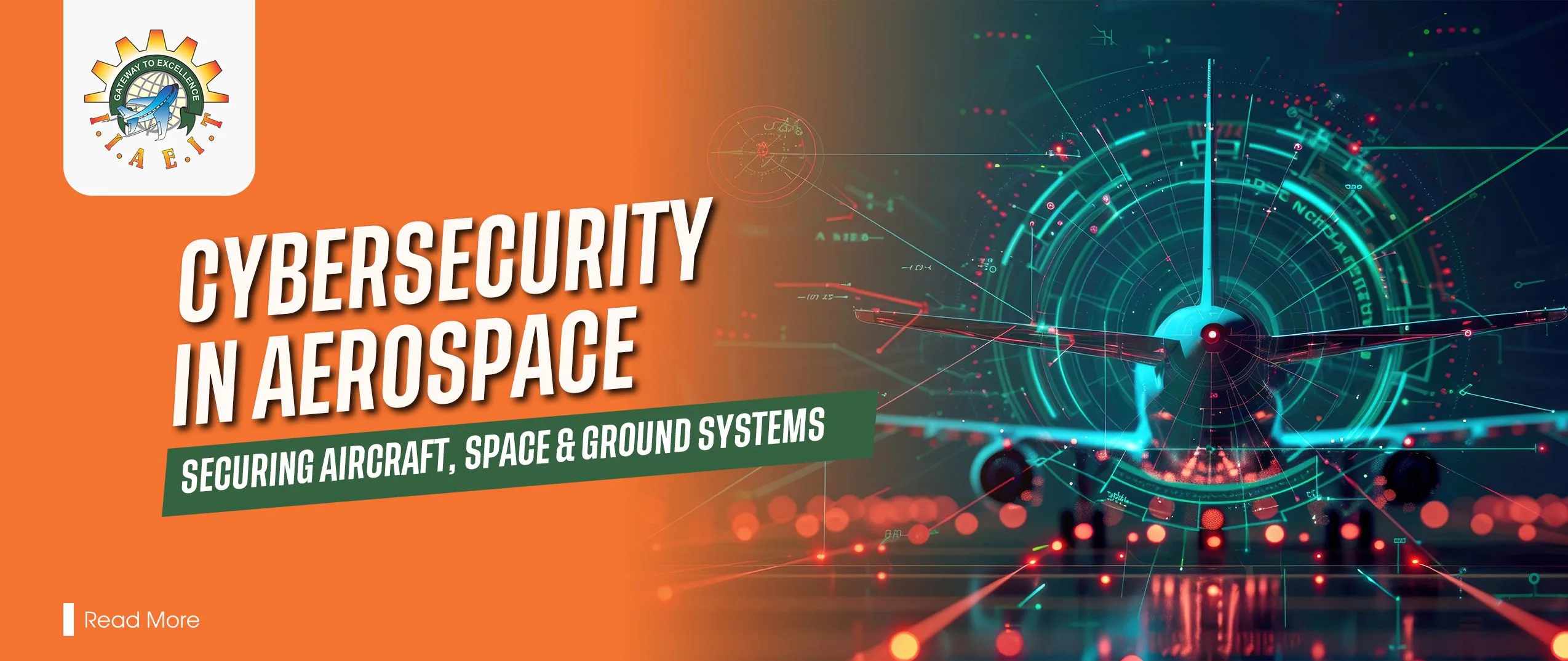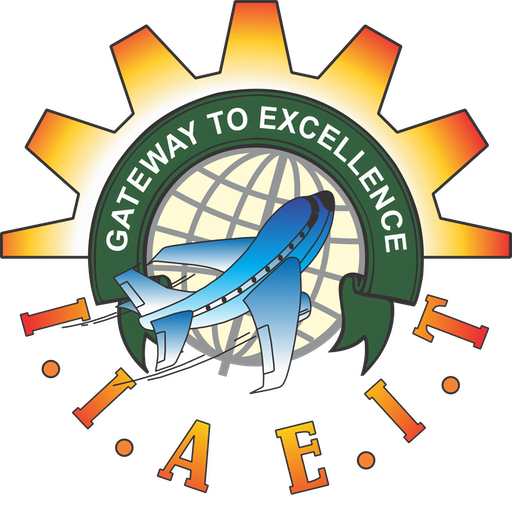Introduction
As airlines adopt digital cockpits, airports automate air-traffic control, and India’s space missions push new boundaries, the aerospace sector has become a prime target for cyber criminals. A single hacked signal or compromised maintenance port can ground an entire fleet or disrupt satellite communications. Cybersecurity in aerospace has become a demand, as a frontline defence for aircraft, airports, and even orbiting satellites.
The urgency is especially clear for India’s fast-growing aviation industry. Ransomware attacks on airport networks, GPS spoofing of aircraft, or breaches in supply-chain software can have consequences far beyond financial loss; they can endanger passenger safety and national security. For aspiring aerospace professionals, mastering cybersecurity is not optional – it’s the key to safeguarding future skies.
What “Cybersecurity in Aerospace” Really Covers?
Aerospace cybersecurity protects three interconnected domains, airborne, ground, and space systems, each with its own vulnerabilities and attack paths.
1. Airborne Systems (Avionics & Integrated Modular Avionics – IMA)
Modern aircraft are essentially flying networks. Avionics computers manage flight controls, navigation, and communication. A single exploited data bus or maintenance port could compromise critical systems. If a hacker sneaks in through a data connection or a maintenance port, it could affect how the plane flies.
2. Ground Infrastructure (Airports, Air Traffic Control, MRO)
Airports and ATC centers run on complex operational technology (OT) networks – baggage handling, fueling, and routing all depend on connected systems. A malware or ransomware attack here can delay flights, disrupt supply chains, or even cause cascading failures. Maintenance, Repair, and Overhaul (MRO) facilities are another target: attackers may infiltrate through software updates or unprotected terminals.
3. Space Systems (Satellites and Communication Links)
From GPS satellites guiding aircraft to earth observation systems supporting defence operations, space assets are vital. Attacks on satellite communication (SATCOM) links, ground stations, or telemetry data can disrupt navigation, weather forecasting, or national security missions.
Common Ways Attacks Happen
- Supply Chain Weaknesses: Hackers insert malicious code into vendor software or hardware.
- Unsecured Maintenance Ports: Exploiting connections used during routine servicing.
- Wireless Signal Attacks: Jamming or faking GPS or communication signals.
Cyber Threats: Challenges in the Aviation Industry
The aviation industry has become one of the most connected and, therefore, most vulnerable sectors in the world. As aircraft, airports, and satellites exchange vast amounts of data, cyber criminals are finding more ways to exploit weak points. Here are some of the key threats and challenges:
- Malware and Ransomware on Airline IT and Airport OT Systems
Ransomware attacks have already crippled airline reservation systems and baggage-handling operations in recent years. A well-timed breach can cascade across global schedules, costing millions and stranding passengers far from home.
- Aircraft and Avionics Risks
Today’s aircraft are flying data centers. Integrated Modular Avionics (IMA) systems manage flight controls, communications, and navigation. A compromised data bus or unsecured maintenance interface could, in theory, allow attackers to interfere with vital functions mid-flight—a risk too great to ignore.
- GPS Spoofing and Signal Jamming
From drones to passenger jets, navigation relies heavily on GPS signals. Hackers can jam or falsify these signals, sending aircraft off-course or disrupting automated air traffic control. Even short interruptions can trigger delays, diversions, or emergency procedures.
- Supply-Chain Breaches and Insider Threats
With thousands of vendors providing hardware, software, and updates, the supply chain is a hacker’s playground. A hidden backdoor in a component or an insider leak can compromise security long before takeoff.
- Global Compliance Complexity
Airlines and aerospace firms must satisfy overlapping regulations—from the FAA and EASA to ISRO and HAL. Meeting these standards while innovating quickly is a balancing act that challenges even the biggest industry players.
- Shortage of Skilled Cybersecurity Engineers
The industry urgently needs professionals who speak two languages: aviation systems and cybersecurity. This rare skill set is in short supply, making trained aerospace cyber engineers some of the most sought-after specialists in technology today.
Career in Aerospace Cybersecurity
Every aircraft system update, satellite transmission, or airport network login is a potential doorway for cyber attackers. This dynamic has created a powerful demand for professionals who can bridge aerospace engineering and cybersecurity; a rare combination of skills that can shape the future of global aviation.
| Role | What They Do |
| Avionics Security Analyst | Safeguards flight control software, navigation systems, and communication links inside aircraft. |
| SATCOM Security Specialist | Protects satellite communication channels and ground stations that guide aircraft and space missions. |
| OT Security Engineer (Airports/ATC) | Secures operational technology networks, baggage systems, and air traffic control platforms. |
| Aerospace Cyber Incident Responder | Investigates breaches, isolates compromised systems, and restores safe operations. |
| AI-Driven Threat Detection Engineer | Develops machine learning models to spot unusual patterns or attacks before they escalate. |
Why the Demand Is Growing?
- Global Aviation Expansion: More connected aircraft and autonomous systems mean more vulnerabilities.
- Regulatory Pressure: FAA, EASA, and Indian aerospace authorities are tightening cybersecurity standards, creating new roles.
- Space Missions and UAV Growth: Drones, satellites, and commercial space ventures add new attack surfaces needing protection.
How does IIAEIT prepare you for Cybersecurity in Aerospace?
IIAEIT bridges the gap between advanced aerospace engineering and cutting-edge cybersecurity, equipping students to meet global cybersecurity standards and solve complex aerospace challenges.
Integrated Learning Across Programs
- B.Tech Aerospace Engineering – Introduces avionics fundamentals, secure communications, and embedded systems security.
- M.Tech Aerospace Engineering – Dives deeper into network security for SATCOM, advanced avionics architectures, and compliance with global standards.
- Dual Degree (B.Tech + M.Tech) – Offers extended research opportunities in cyber-resilient aerospace systems and space mission security.
Hands-On Labs and Simulations
- UAV & Avionics Cyber Labs – Students test vulnerabilities in flight control software and learn to harden integrated modular avionics.
- SATCOM & Ground Station Exercises – Practice securing satellite communication links and protecting ground control systems.
Industry Collaborations and Mentorship
- Partnerships with Aerospace Firms and Research Bodies – Exposure to projects inspired by ISRO, DRDO, and leading drone startups.
- Expert Sessions – Guest lectures by aviation cybersecurity specialists, AI threat detection engineers, and compliance auditors.
- Capstone Projects – Real-world challenges such as secure UAV swarms, SATCOM encryption, or zero-trust architectures for ATC.
Conclusion
From protecting flight control systems and satellite links to securing airport networks, every part of the aviation ecosystem now depends on robust digital defence. The threats are real; malware, GPS spoofing, ransomware, and supply-chain breaches can disrupt operations, compromise safety, and impact national security.
IIAEIT equips future engineers with the technical skills, hands-on experience, and industry connections needed to thrive in this high-stakes field. Whether through its B.Tech, Dual Degree, or M.Tech programs, the institute prepares you to be more than an engineer; you become a guardian of the skies and space.
FAQs
- What are the biggest cyber threats facing aviation today?
Malware, ransomware, GPS spoofing, supply-chain breaches, and insider attacks targeting aircraft systems, airport networks, and satellite communications.
- How is AI used to improve aerospace cybersecurity?
AI detects unusual network patterns, predicts threats, automates responses, and strengthens real-time protection for avionics, satellites, and air traffic systems.
- Which certifications or standards should aerospace engineers know?
DO-326A/ED-202A guidelines, FAA AC 119-1A, EASA NPA 2019-01, and NIST cybersecurity controls are widely recognized in aerospace cybersecurity.
- Can aerospace cybersecurity be a career in India?
Yes. India’s expanding aerospace sector, ISRO missions, DRDO projects, and Make-in-India initiatives create a growing demand for skilled aerospace cybersecurity professionals.


